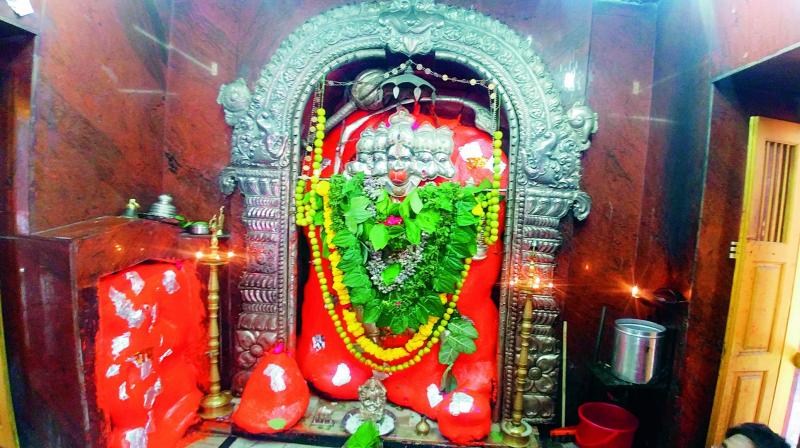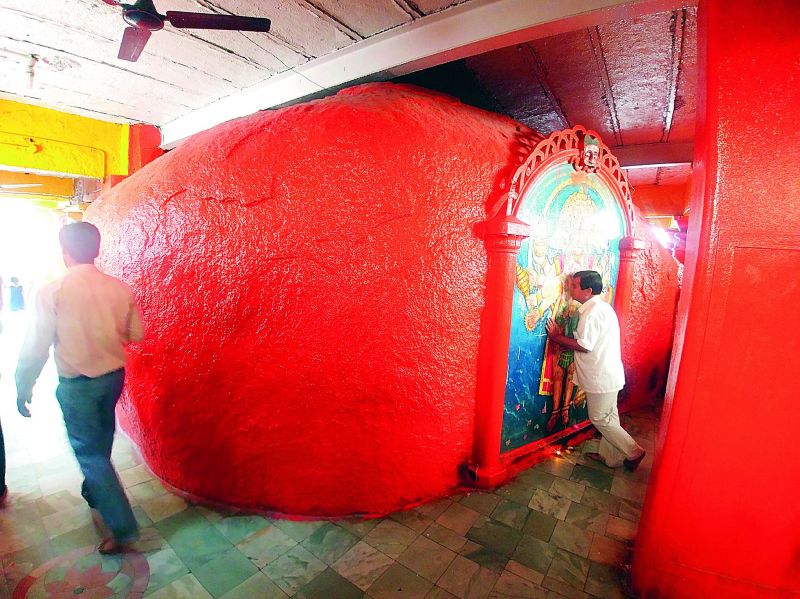Swayambhu saga: Panchamukhi temple Where power' reigns

Hyderabad: The Panchamukhi Hanuman temple is next to the Secunderabad railway station, at Ghasmandi Road. You can hear the trains honk as they pass by. The narrow road leads to the ever-crowded Monda Market. Names are lost in the hoary past and the family that still has a presence here, but is not in control of the temple, does not remember too much about the past.
“This was a place where sadhus would congregate and meditate,” says Bhavani Mahant, son of late Sham Das, the younger brother of late Gulab Das, who really brought this 500-600-year-old temple to life. Gulab Das died a decade ago and till then actively looked after it. The Panchamukhi Hanuman here is swayambhu and is supposed to have given darshan to Pancham Das, who was the first priest to come here from Varanasi. “Hanumanji unko darshan diye aur prakat hue,” Bhavan Mahant says.
 The swayambhu Hanuman emerged on a humongous rock, which is suitably painted a vivid orange, symbolic of Lord Hanuman. (Photo: DC)
The swayambhu Hanuman emerged on a humongous rock, which is suitably painted a vivid orange, symbolic of Lord Hanuman. (Photo: DC)
When and why Pancham Das came here is not known to anyone. It could have been because someone told him to travel to Secunderabad for prayers and blessings at the feet of the sadhus. After Pancham Das, his son Baldev Das took over. He was a contractor for the British who were here to build the roads, raise an army, and run the railways. The station being next door to the temple helped Baldev Das.
“He was very much into development,” says Sheela Mahant, widow of Pancham Das, son of Gulab Das. She has three sons and a daughter and while one has gone abroad, the other two sons visit the temple once in a while even though they hold high-tech jobs. Baldev Das added two mandapams to the basic temple. The swayambhu Hanuman is emergent on a humongous rock, which is suitably painted a vivid orange, symbolic of Lord Hanuman, and as you perambulate, you see the painting of Lord Hanuman right behind where the main icon is. The paint has practically peeled off with all the devotees worshipping the painted icon.
Since Baldev Das had two daughters, it was his grandson Gulab Das who took over. He brought about a lot of changes within this small temple. There were small icons of Shiva, Ganesha, Naga Devata and Navagraha and he built tiny temples for these icons too, allowing people to do their own puja. In fact thanks to Gulab Das, the temple doors are also well endowed with silver frames.
“While I am not aware of any miracles, I can say that people come here with a wish and when it is fulfilled they come back and contribute a lot to the temple. That is how I know that the Panchamukhi Hanuman is very powerful. Then they become devotees who come regularly,” says Sheela Mahant. Most of the development of the temple has been done through the resources and because of the interest of the family.
Sheela Mahant is extremely unhappy with the endowments department. “Thanks to some mischief makers in the temple, the department officials one day walked in without any notice and sealed off the hundis,” she says. “Since there was no elderly male figure at that time, they could do it, but it is of no help them taking over, for they do not contribute anything towards the development of the temple,” she says, a tad angrily. And this is in spite of the Supreme Court ruling that the hereditary founder family can run a temple.
“Our livelihoods have been affected by this single act of the Endowments Department,” says Sheela Mahant. She herself comes from a religious family, with her father being the head priest of yet another Hanuman temple in Mumbai, called the Picket Road Maruthi Temple. Each year during Hanuman Jayanti, the main icon gets a treatment and the Sindhoor, which is the main colour of Lord Hanuman, is slowly removed. Several layers get formed over the year and for the safekeeping of the original icon, this is done. The day after Hanuman Jayanti is annadanam or ‘annakoot’ as they call it.
Sheela Mahant lives in a house which is more than 100 years old, sharing the wall of the temple. A narrow staircase leads to small rooms, with flowers and small trees growing cheerfully out of the crevices of the old building and a huge terrace, making it a charming place. The temple as a structure came into existence close to 300 years ago. Since this is a Panchamukhi Hanuman, each and every face of Sri Panchamukha Hanuman has great significance. There are five faces - Hanuman, Narasimha, Garuda, Varaha and Hayagriva. Sri Hanuman faces towards the East, granting purity of mind and success.
The Narasimha faces South granting victory and fearlessness. The West facing Garuda removes black magic and poisons in any given situation, and the North facing Varaha showers prosperity and wealth. Hayagriva Mukhi faces towards the sky, and gives knowledge and good children. The puja is conducted accordingly and the devotee is asked to look in all the directions for the best effect.
According to the local legends, the Lord promises special security to all his devotees. The entrance arch and the gopuram have been retained in their original form and both are dust-ridden with old flowers still dotting the place; two-wheelers parked haphazardly make the road narrower. The smell of spices wafting in from the shop next door adds to the ancient feel of the temple. The aroma permeates the air as the bells cling in unison every time an aarti is shown.

